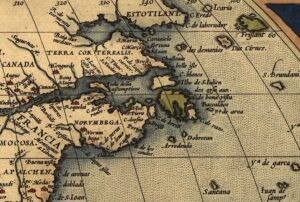The SS Baychimo began as an ordinary cargo ship. Initially called the Ångermanelfven, it began operations in 1914 in Sweden during the First World War. Seventy meters long, it had a decent steam engine and a steel hull.
It served as a trading vessel, mostly between Sweden and Germany. After the war ended, the British seized it as reparations from the Germans. The Hudson’s Bay Company of Canada bought it in the 1920s for about $18,000. It then took the name SS Baychimo.

Crewmen try to clear ice from around the Baychimo’s rudder. Photo: Hudson Bay Company Archives
The Hudson’s Bay Company kept the vessel busy for some years, often in the far north. It sailed from its home port in Scotland to Siberia, Alaska, the Yukon, and the Northwest Territories. It also passed through the Panama Canal and even the Suez Canal, trading in fur pelts. Occasionally, it transported passengers. The vessel withstood the seas on nine separate voyages. This streak of good fortune eventually came to an end.
Bad luck
From 1931 onward, the vessel experienced a series of run-ins with pack ice and storms. In October 1931, it became trapped in the ice, like so many earlier arctic vessels.
Some of the crew made their way to the nearby town of Barrow, Alaska, but 15 of the 22 men chose to stay behind to try and release the vessel or at least salvage the $58,000 of furs and other cargo. The Hudson’s Bay Company sent supplies to help them overwinter. According to an article in The Beaver — a history magazine founded by the Hudson’s Bay Company — the men built a shelter from “hatches, tarpaulins, and other materials” on the ice near the ship. They also offloaded the cargo.

Baychimo stuck in ice. Photo: Hudson’s Bay Company Archives, Archives of Manitoba
On November 24, a blizzard hit the area. After it passed, the vessel was nowhere in sight. The ice platform on which the men had camped remained solid, but the ship had been ripped free of its icy prison. Many of the crew thought it sank.
Not long after, an Inuit hunter contacted them to say that he had seen it 72km south. And so began the saga of the runaway ship…
The runaway ship
The crew went back to their lives, the ship drifted through arctic waters for many years as a ghost vessel. It was spotted in 1933, 1934, 1935, and 1939, and intermittently up to 1969. This made it one of the longest-sailing ghost ships in history. It survived unmanned for 38 years.
Three groups boarded it briefly in the 1930s but failed to bring it to shore. Somehow, bad weather always set in. Those who came close enough noted visible damage, such as a missing propeller. Later sightings reported it listing.
The last recorded glimpse of the SS Baychimo was in 1969.
Where did it sink?
No one truly knows how it managed to stay afloat for so long. But author Anthony Dalton suggests that it drifted with the currents and winds of the Beaufort and Chukchi Seas. Somewhere in that area, it found its final resting place.
The latest attempt to solve the mystery came in 2006. The Alaskan government sought to find and recover ships lost in Alaskan waters. An estimated 4,000 ships had disappeared off its shores. Unlike Franklin’s Erebus and Terror, the ship continues to elude searchers. Until a ship passes overhead with its sonar on, or a revealing artifact from the Baychimo washes ashore, we are left adrift in a sea of unanswered questions.






